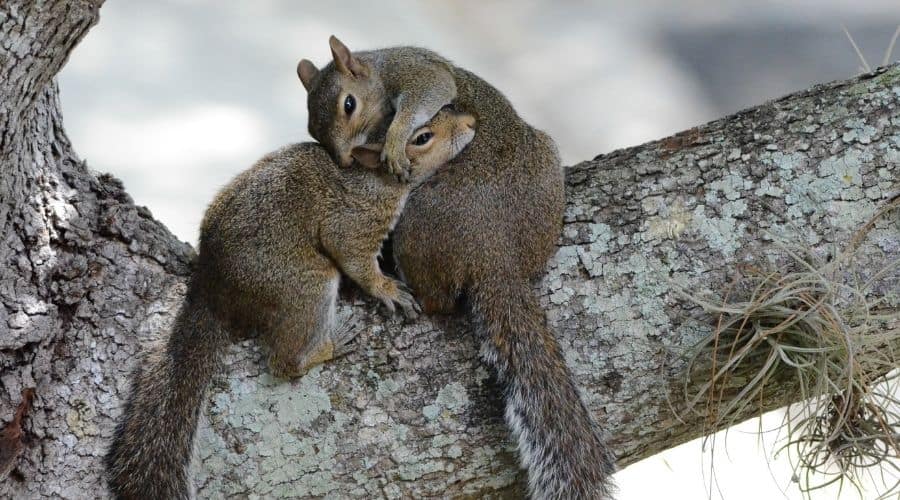Metabolic Bone Disease is a severe problem for squirrels, and it can kill them. However, numerous other alarming side effects of this troublesome calcium and phosphorous imbalance appear long before it gets bad enough to kill.
Seizures and paralysis are among the most common side effects. Why do squirrels have seizures? MBD isn’t the only reason squirrels have seizures, so read on, and I’ll explain everything you need to know about potential causes.
Squirrels have seizures because they have Metabolic Bone Disease, a condition where they aren’t absorbing enough calcium. Their body becomes very weak, and in severe cases, they can lack the use of their back legs. It’s vital for squirrels, both in the wild and domestic, to have the right balance of vitamin D, phosphorous, and calcium in their diet.
Table of Contents
Why Would A Squirrel Have A Seizure
The most common reason for a squirrel to have a seizure is MBD. However, it’s not the only possible cause of this unfortunate affliction.
Below I’ve created a quick list of potential culprits, but you should always consult a professional immediately if your squirrel has a seizure. Only a vet can properly diagnose the issue and offer treatment solutions.
1 – Metabolic Bone Disease
According to ISLC, symptoms of Metabolic Bone Disease include, “… the squirrel begins having seizures between 2 and 3 months old (you may not notice the seizures because they are at first very short and mild and may take place when the baby is out of your sight). Paralysis may or may not appear at this time but will surely appear at some point. The animal will sometimes be obviously in pain, crying, or stiff with limited motion. There will sometimes be a drop in appetite. If the condition goes untreated, the squirrel will die.”
2 – Brain Damage
A baby squirrel, or in rare cases an aul that has taken significant trauma to the head, may have irreversible brain damage. While this doesn’t always manifest as seizures, it can.
3 – Infection
Infection from an injury can cause sepsis and even kill a squirrel. However, a very infected squirrel may have seizures as the condition progresses.
4 – Poison
Squirrels have excellent noses and are superb at finding viable food sources for themselves. However, the prevalence of pesticides and other toxins that humans accidentally expose wildlife can lead to seizures.
Why Do Baby Squirrels Have Seizures
There is good and bad news if you have a baby squirrel between eight and twelve weeks old that suddenly develops seizures.
The unfortunate part is that it almost certainly has Metabolic Bone Disease because this is when the early symptoms show up.
Happily, the good news is that your baby squirrel can thrive with proper care, sunshine, and calcium supplements.
That said, calcium will take time to work. You may be in for several months of alarming incidents before things start to improve noticeably.
Nevertheless, a baby squirrel with MBD often has a favorable prognosis if you can get them to the vet and ensure they have a proper diet after that.
Alternately, if the baby squirrel is younger than two months or clearly fell from a tree, you may be looking at brain injury-related seizures.
Please seek help from a veterinary or squirrel rehabilitation expert right away. Your little squirrel may still be able to live a full and productive life, but calcium isn’t going to ‘fix it.’
Finally, a baby squirrel that appears weak and arches backward may be seizing due to hypoglycemia. Mother’s milk is rich in sugars that give the baby energy.
You can try placing a tiny amount of jelly, Karo syrup, or honey on its tongue to help bring it out of this state.
My Squirrel Is Having Seizures! What To Do
If the squirrel is a baby and shows signs of hypoglycemic seizures, you can carefully offer it tiny amounts of sugary semi-liquids.
Please be careful not to overdo it and choke the baby. Use your fingertip or something small and rub the sugary food on its tongue and mouth.
If it’s receptive you can rub it inside the mouth. Then wait a few minutes before attempting to repeat the process.
For other squirrel seizures, your best bet is to take it to the vet or animal hospital as soon as the episode passes. It is never a good idea to try and pick up a squirrel mid seizure. You may hurt them or vice versa.
What Does A Squirrel Seizure Look Like
A squirrel seizure can look like shaking and twitching. However, it can also look like clawing at the air or involve panicked squirrel screams.
It will appear more like back arching and may include eyes rolling up in some cases. The best way to familiarize yourself with what seizures look like in squirrels is to see it for yourself.
Squirrel Seizure Video
The sweet little squirrel in this video had a cleft palate. As a result, her teeth were overgrown, and she likely wasn’t eating properly since she couldn’t wear down or sharpen her teeth.
You can see the erratic, frantic seeming movements as she seizes. Sadly, this is one squirrel who will need a lifetime of care in a sanctuary.
Helpful Tips To Know About Why Squirrels Have Seizures
Squirrels can have seizures due to brain injuries and other illnesses, but the most common reason in adult squirrels is Metabolic Bone Disease. In very young squirrels, the cause is more likely to be brain damage from falling out of their nest.
Here are more helpful tips to know about why squirrels have seizures.
- It can be challenging to tell the exact cause of a squirrel seizure, especially if you have never seen one. The best option is to go directly to a rehab center, vet, or animal hospital for a professional assessment.
- Metabolic Bone Disease is prevalent in pet squirrels. Well-meaning caretakers fail to offer the right blend of foods, choose the wrong nuts, or simply don’t get the squirrel enough sunlight. Tragically, the result for the squirrel is excruciatingly painful and can result in loss of function in the back legs or even death.
- Wild squirrels prevent MBD by chewing on high calcium ‘snacks’ like animal bones or discarded deer antlers. This form of chewing also helps keep their teeth from becoming overgrown or dull. Unfortunately, this type of gnawing is so pervasive that it often interferes with crime scene investigations. As Futurity explains, “It is vital for forensic anthropologists to understand this toothy habit since squirrel-gnawing can drastically affect human skeletal remains that are left to the elements. They might also scatter the bones away from the original site, disturbing the integrity of the skeleton. The damage rodents can cause and tooth marks they leave, sharp as knife strikes, can both confound and inform crime scene investigators.”
Final Thoughts
The same problem causes the vast majority of squirrel seizures. Metabolic Bone Disease is widespread, painful, traumatic, and often deadly to squirrels.
Happily, MBD can be stopped and reversed with a proper diet and plenty of sunshine. Baby squirrels also have seizures due to hypoglycemia or traumatic brain injuries after falling from their nest.
Whatever the cause, it’s crucial to get a proper diagnosis so you can help the squirrel or turn it over to a professional squirrel rehabilitation center.

